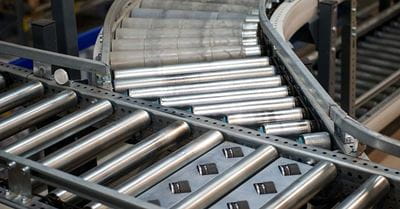Sortation Systems | Phoenix

Raymond West supplies a full range of conveyor and automation products, including all types of sortation solutions.
To speak with an automation expert, phone us at (602) 275-2228.
Are you thinking about a sortation solution for your Phoenix warehouse, distribution center or manufacturing facility? The most popular kinds of sortation systems vary greatly in capability and expense. Below we provide a high level synopsis of the advantages and drawbacks of the most popular kinds of sortation systems.
Cross-Belt Sorter & Tilt Tray Sorter
Cross-belt and tilt-tray sortation systems deliver comparable functionality and are commonly associated when covering sortation mechanization. In reality they are very different mechanisms.
Tilt-tray sorters are made up of trays attached to carts that are carried on a continuous-loop conveyor. Products are put into the trays at one or more induction positions on the loop via manual or automated processes. When a product reaches its sorting destination, the tray that is transporting it tips and deposits the product onto a chute.
Cross-belt sorters are electric belt conveyors mounted to carts operating on a continuous conveyor loop. Comparable to tilt-trays, cross-belt sorters move materials onto a chute when they reach the appropriate sorting destination.
Advantages: Tilt-tray and Cross-belt sorters offer the greatest sorting rate and can deal with a wide range of product types in comparison with other sortation solutions. They are a great alternative for operations that deal with a wide array of SKUs. These kinds of systems are also relatively noiseless and enable a more comfortable work environment for warehouse workers.
Disadvantages: The speed, capacity and flexibility or these sorters come at a price-- they are some of the most expensive sortation choices on the market.
Shoe Sorter
Sliding shoe sorters use a "shoe" system connected to the conveyor surface that nudges and diverts items onto a secondary, after-sort conveyor. Shoe sorter configurations are fed by a unified stream of products that may be a mixed feed from several upstream areas of a warehouse. These kinds of sortation solutions are widely used in shipping applications.
Advantages: Sliding shoe sorter equipment setups can accommodate a relatively high peak rate, often several hundred products per minute, depending upon the unit weight and size. Furthermore, a wide range of items can be handled because of the simplicity and versatility of a positive divert system.
Disadvantages: Shoe sorters are more costly than other alternatives like pop-up wheel sorters. Also, divert areas are not freely movable, making the system difficult and costly to rearrange. These systems also produce more decibels than belt or tray systems and are therefore not as worker-friendly as other kinds of sorters.
Pop-up Wheel Sorter
Pop-up wheel sorters are a popular choice since they are fairly economical and easy to implement. Wheels or rollers are embedded in a belt conveyor. When a product must be diverted, the wheels pop up to divert items at an angle to a secondary, downstream conveyor.
Advantages: Pop-up wheel sorters are modular, so sections can be rapidly added or taken away when the line needs reconfiguration. These systems can likewise be substantially less costly than other sorter options.
Disadvantages: These types of sorters deliver quite a bit less performance and capability than tilt-tray, cross-belt or shoe options. They will undeniably boost performance, yet might not multiply total output like other solutions. Because pop-up systems do not provide a positive divert, the kinds of products they can process are reduced.
Automated Sortation Systems Near Me
To get more guidance on sortation alternatives, call an automation expert at Raymond West Inc today!
Raymond West Inc
2659 E Magnolia St
Phoenix, AZ 85034
(602) 275-2228
You May Also Like:

Conveyor Repair | Phoenix
Raymond West is a Phoenix warehouse automation equipment supplier. We offer repair and service for many types of conveyor systems. Call us today at (602) 275-2228.
Learn More

Conveyor Systems
Conveyors can greatly improve the efficiency and productivity of your warehouse while reducing labor costs.
Learn More

Order Picking Systems | Phoenix
We design, install and maintain state-of-the-art order picking solutions for all types of warehouse and distribution center operators.
Learn More

Pallet Shuttles
We supply a full range of warehouse automation equipment including pallet shuttle systems. If you'd like to find out more about automation possibilities for your warehouse, give us a call today.
Learn More

